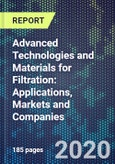Innovation in the global filtration market has increased considerably in recent years. Social needs for cleanliness, health and comfort are rising. There is an increasing demand for air filters with a high collection performance for indoor and outdoor air cleaning as well as waste gas treatment. Indoor air contaminants, such as volatile organic compounds (VOCs), microorganisms, allergens, and other pollutants (e.g., tobacco smoke) pose serious health- and productivity-related problems for occupants of indoor spaces.
The importance of improved water disinfection and microbial control cannot be overstated, and there is a huge market need for decentralized/point-of-use water treatment and reuse systems. With increasing instances of pollution both above and underground, the need for technological advances to treat water becomes even more pressing. Advanced water filtration materials are contributing greatly to applications such as desalination, nanofiltration, ultrafiltration, and microfiltration.
Various advanced filter technologies have been developed for enhanced healthcare and improving comfort, as well as industrial applications. Advanced materials have the clear potential to greatly benefit environmental quality and sustainability, through pollution prevention, water treatment and remediation. Benefits include the improved detection and sensing of contaminants and pollution and their safe removal and filtration from air, water and soil, at a greatly reduced cost in comparison to existing technologies.
Report contents include:
- Overview of the global market for advanced filtration technologies.
- Market revenues, current and forecast by types of filter and end-user market, including data for 2017, 2017 and forecasts to 2030.
- Market revenues by region to 2030.
- Commercialization roadmaps.
- Analysis of properties and applications of advanced filtration materials such as activated carbon, metal-organic frameworks (MOFs), nanofibers, carbon nanotubes, graphene, cellulose nanofibers, bacterial cellulose, oxide nanoparticles, dendrimers and new 2D materials.
- Application opportunity analysis matrix for advanced filtration applications.
- Analysis of advanced filtration technologies and materials in membranes, desalination, water treatment, air filters, oil and gas and virus filtration end-user markets.
- >100 company profiles including Ahlstrom-Munksjö, 3M, Unitika, Artveoli, Arvia Technology, Asahi Kasei, Donaldson Company, Inc., Dupont, Finetex, General Electric, G2O Water Technologies Limited (G2O), Directa Plus, Irema-Filter GmbH, Japan Vilene Company Ltd., Lockheed Martin, Mattershift, CSIRO, MOF Technologies, Nitto Denko, Revolution Fibres Ltd, Teijin etc.
This product will be delivered within 1-3 business days.
Table of Contents
Companies Mentioned (Partial List)
A selection of companies mentioned in this report includes, but is not limited to:
- 3M
- Ahlstrom-Munksjö
- Artveoli
- Arvia Technology
- Asahi Kasei
- CSIRO
- Directa Plus
- Donaldson Company
- Dupont
- Finetex
- G2O Water Technologies Limited (G2O)
- General Electric Inc.
- Irema-Filter GmbH
- Japan Vilene Company Ltd.
- Lockheed Martin
- Mattershift
- MOF Technologies
- Nitto Denko
- Revolution Fibres Ltd
- Teijin
- Unitika
Methodology

LOADING...








